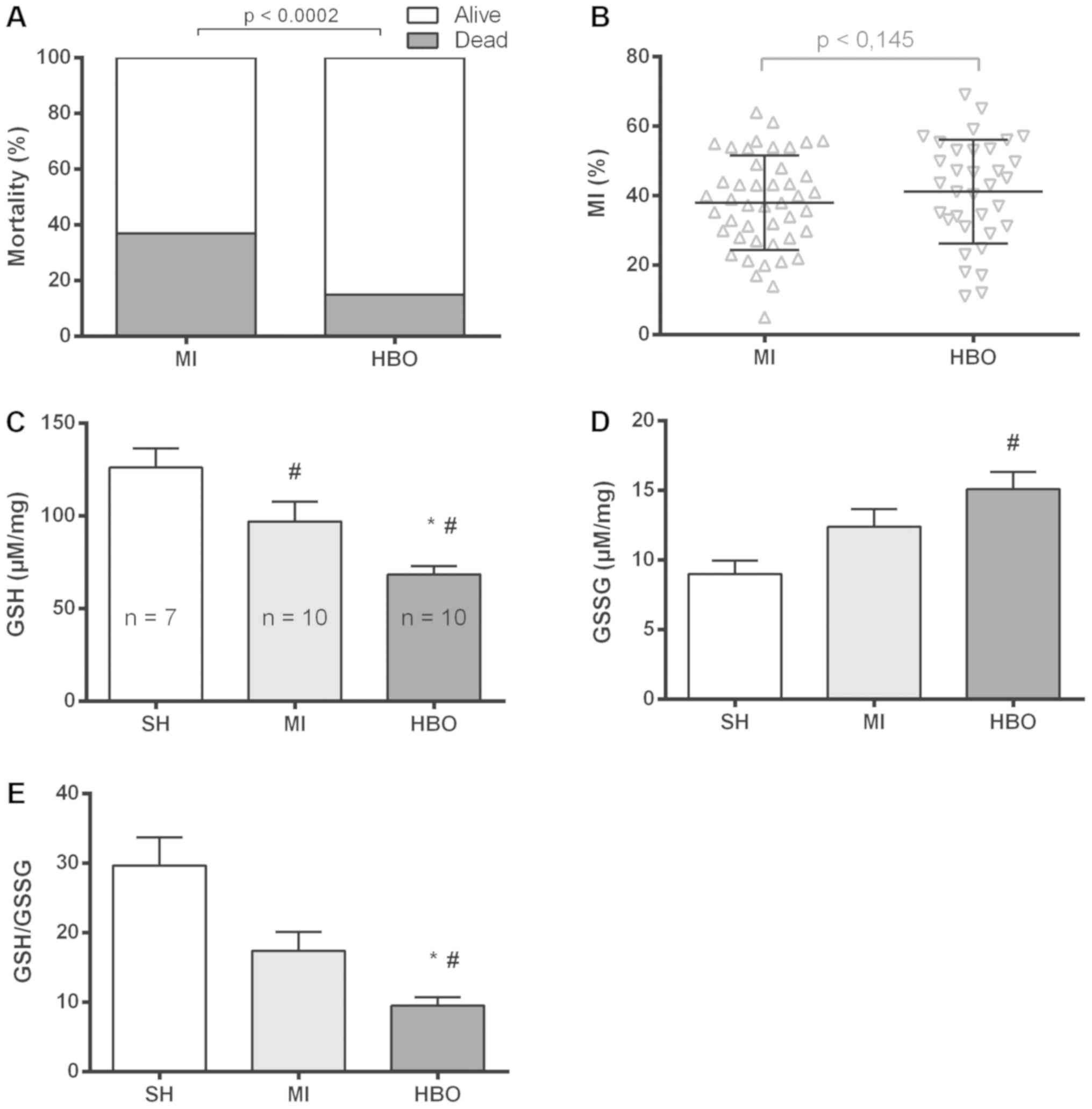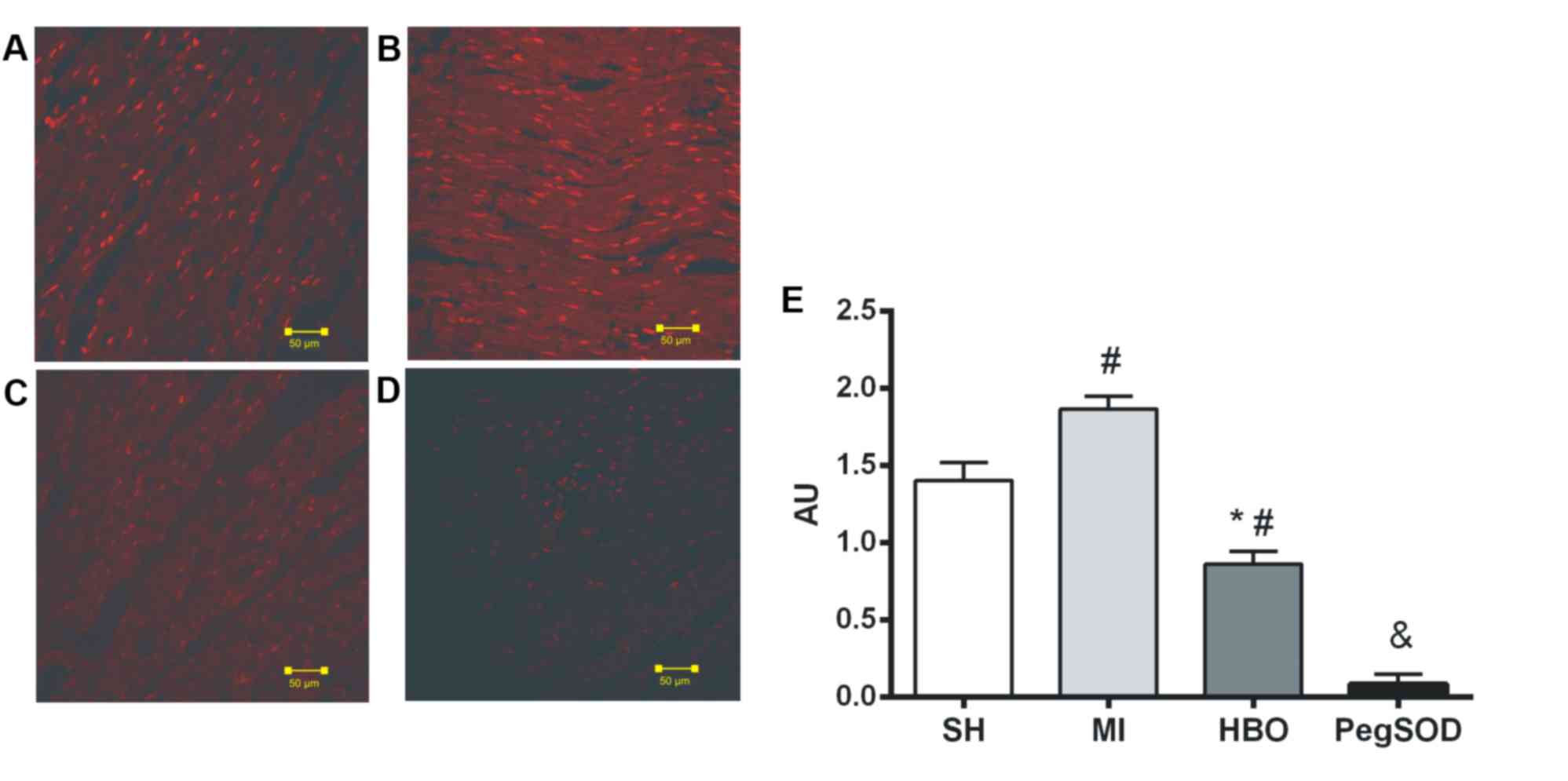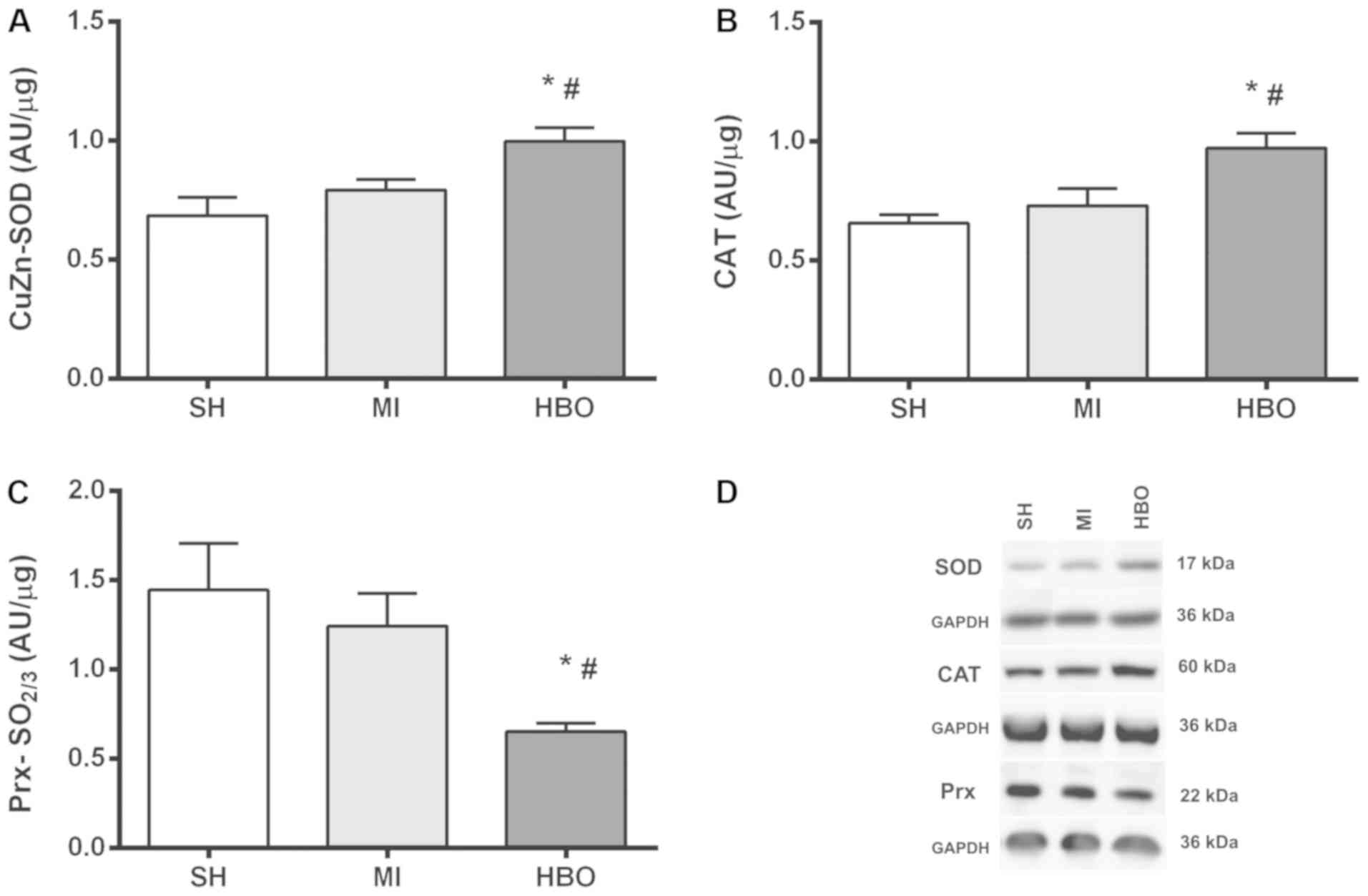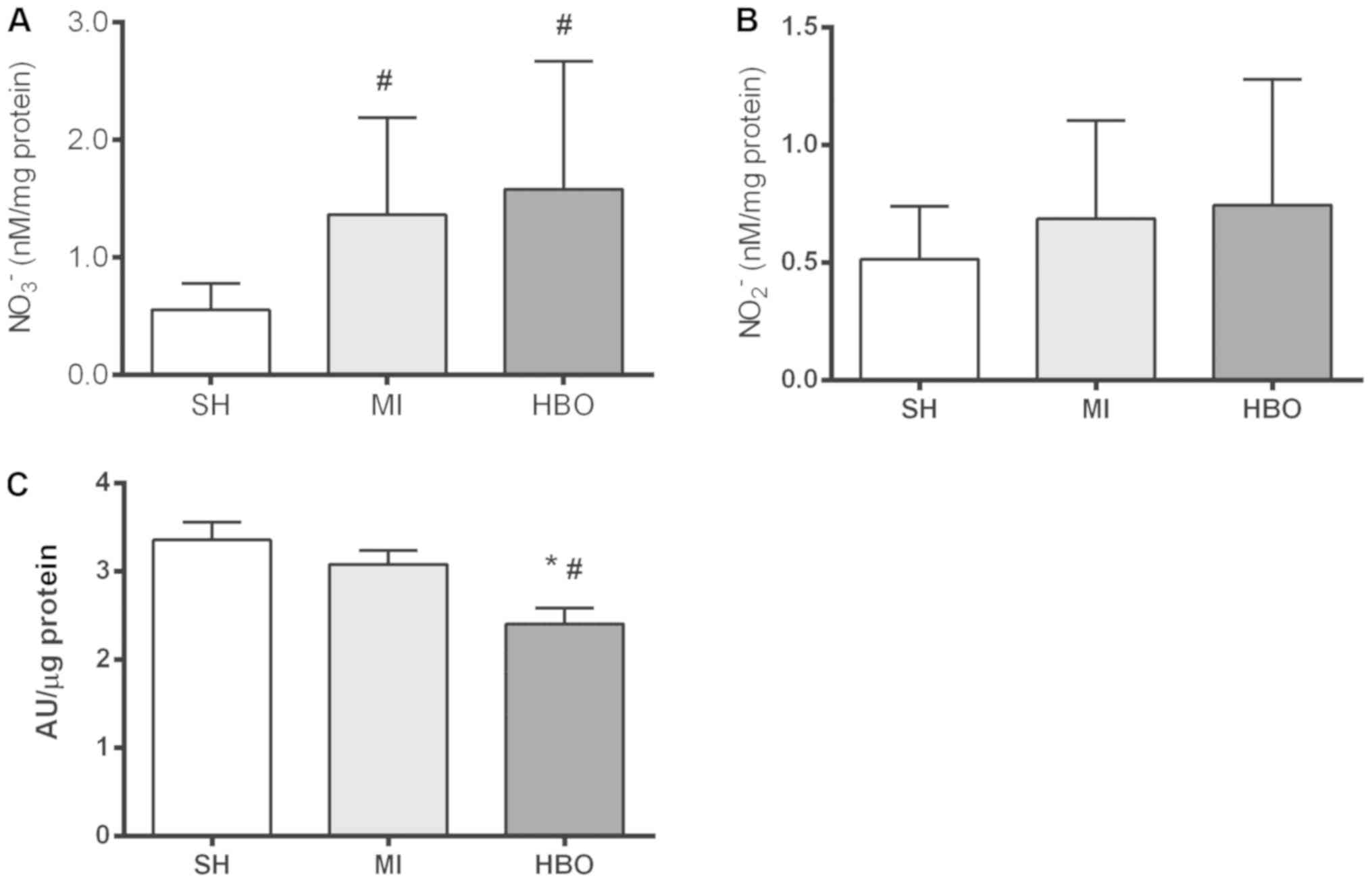|
1
|
Braunwald E and Kloner RA: Myocardial
reperfusion: A double-edged sword? J Clin Invest. 76:1713–1719.
1985. View Article : Google Scholar : PubMed/NCBI
|
|
2
|
Bulluck H, Yellon DM and Hausenloy DJ:
Reducing myocardial infarct size: Challenges and future
opportunities. Heart. 102:341–348. 2016. View Article : Google Scholar : PubMed/NCBI
|
|
3
|
Facundo HT, Carreira RS, de Paula JG,
Santos CC, Ferranti R, Laurindo FR and Kowaltowski AJ: Ischemic
preconditioning requires increases in reactive oxygen release
independent of mitochondrial K+ channel activity. Free
Radic Biol Med. 40:469–479. 2006. View Article : Google Scholar : PubMed/NCBI
|
|
4
|
Granger DN and Kvietys PR: Reperfusion
injury and reactive oxygen species: The evolution of a concept.
Redox Biol. 6:524–551. 2015. View Article : Google Scholar : PubMed/NCBI
|
|
5
|
Zhang Y, Sano M, Shinmura K, Tamaki K,
Katsumata Y, Matsuhashi T, Morizane S, Ito H, Hishiki T, Endo J, et
al: 4-hydroxy-2-nonenal protects against cardiac
ischemia-reperfusion injury via the Nrf2-dependent pathway. J Mol
Cell Cardiol. 49:576–586. 2010. View Article : Google Scholar : PubMed/NCBI
|
|
6
|
Fröhlich GM, Meier P, White SK, Yellon DM
and Hausenloy DJ: Myocardial reperfusion injury: Looking beyond
primary PCI. Eur Heart J. 34:1714–1722. 2013. View Article : Google Scholar : PubMed/NCBI
|
|
7
|
Bennett MH, Lehm JP and Jepson N:
Hyperbaric oxygen therapy for acute coronary syndrome. Cochrane
Database Syst Rev. CD0048182015.PubMed/NCBI
|
|
8
|
Undersea and Hyperbaric Medical Society:
Indications for hyperbaric oxygen therapy. https://www.uhms.org/resources/hbo-indications.htmlMarch
25–2019
|
|
9
|
Sterling DL, Thornton JD, Swafford A,
Gottlieb SF, Bishop SP, Stanley AW and Downey JM: Hyperbaric oxygen
limits infarct size in ischemic rabbit myocardium in vivo.
Circulation. 88:1931–1936. 1993. View Article : Google Scholar : PubMed/NCBI
|
|
10
|
Tibbles PM and Edelsberg JS:
Hyperbaric-oxygen therapy. N Engl J Med. 334:1642–1648. 1996.
View Article : Google Scholar : PubMed/NCBI
|
|
11
|
Whalen RE and Saltzman HA: Hyperbaric
oxygenation in the treatment of acute myocardial infarction. Prog
Cardiovasc Dis. 10:575–583. 1968. View Article : Google Scholar : PubMed/NCBI
|
|
12
|
Poff AM, Kernagis D and D'Agostino DP:
Hyperbaric Environment: Oxygen and Cellular damage versus
protection. Compr Physiol. 7:213–234. 2016. View Article : Google Scholar : PubMed/NCBI
|
|
13
|
Cabigas BP, Su J, Hutchins W, Shi Y,
Schaefer RB, Recinos RF, Nilakantan V, Kindwall E, Niezgoda JA and
Baker JE: Hyperoxic and hyperbaric-induced cardioprotection: Role
of nitric oxide synthase 3. Cardiovasc Res. 72:143–151. 2006.
View Article : Google Scholar : PubMed/NCBI
|
|
14
|
Jones DP: Redefining oxidative stress.
Antioxid Redox Signal. 8:1865–1879. 2006. View Article : Google Scholar : PubMed/NCBI
|
|
15
|
Kim CH, Choi H, Chun YS, Kim GT, Park JW
and Kim MS: Hyperbaric oxygenation pretreatment induces catalase
and reduces infarct size in ischemic rat myocardium. Pflugers Arch.
442:519–525. 2001. View Article : Google Scholar : PubMed/NCBI
|
|
16
|
Tavares AM, da Rosa Araujo AS, Llesuy S,
Khaper N, Rohde LE, Clausell N and Belló-Klein A: Early loss of
cardiac function in acute myocardial infarction is associated with
redox imbalance. Exp Clin Cardiol. 17:263–267. 2012.PubMed/NCBI
|
|
17
|
Thom SR: Hyperbaric oxygen: Its mechanisms
and efficacy. Plast Reconstr Surg. 127 (Suppl 1):131S–141S. 2011.
View Article : Google Scholar : PubMed/NCBI
|
|
18
|
dos Santos L, Serra AJ, Antônio EL, Hull
HF and Tucci PJ: Hyperbaric oxygenation applied immediately after
coronary occlusion reduces myocardial necrosis and acute mortality
in rats. Clin Exp Pharmacol Physiol. 36:594–598. 2009. View Article : Google Scholar : PubMed/NCBI
|
|
19
|
Guadalupe NBM, Castillo-Hernandez MDC,
Kormanovski A, Lara-Padilla E, Pimentel-Montejano VH, Olaf GV,
Lopez-Mayorga RM and Gustavo GB: Effect of hyperbaric oxygenation
in total antioxidant system, nitric oxide and 3 nitrotyrosine
levels in a rat model of acute myocardial infarct in the absence of
reperfusion. Int J Pharmacol. 11:834–839. 2015. View Article : Google Scholar
|
|
20
|
Kuhn LA, Kline HJ, Wang M, Yamaki T and
Jacobson JH II: Hemodynamic effects of hyperbaric oxygenation in
experimental acute myocardial infarction. Circ Res. 16:499–509.
1965. View Article : Google Scholar : PubMed/NCBI
|
|
21
|
Mogelson S, Davidson J, Sobel BE and
Roberts R: The effect of hyperbaric oxygen on infarct size in the
conscious animal. Eur J Cardiol. 12:135–146. 1981.PubMed/NCBI
|
|
22
|
Thomas MP, Brown LA, Sponseller DR,
Williamson SE, Diaz JA and Guyton DP: Myocardial infarct size
reduction by the synergistic effect of hyperbaric oxygen and
recombinant tissue plasminogen activator. Am Heart J. 120:791–800.
1990. View Article : Google Scholar : PubMed/NCBI
|
|
23
|
Yogaratnam JZ, Laden G, Guvendik L, Cowen
M, Cale A and Griffin S: Hyperbaric oxygen preconditioning improves
myocardial function, reduces length of intensive care stay, and
limits complications post coronary artery bypass graft surgery.
Cardiovasc Revasc Med. 11:8–19. 2010. View Article : Google Scholar : PubMed/NCBI
|
|
24
|
Shandling AH, Ellestad MH, Hart GB, Crump
R, Marlow D, Van Natta B, Messenger JC, Strauss M and Stavitsky Y:
Hyperbaric oxygen and thrombolysis in myocardial infarction: The
‘HOT MI’ pilot study. Am Heart J. 134:544–550. 1997. View Article : Google Scholar : PubMed/NCBI
|
|
25
|
Stavitsky Y, Shandling AH, Ellestad MH,
Hart GB, Van Natta B, Messenger JC, Strauss M, Dekleva MN,
Alexander JM, Mattice M and Clarke D: Hyperbaric oxygen and
thrombolysis in myocardial infarction: The ‘HOT MI’ randomized
multicenter study. Cardiology. 90:131–136. 1998. View Article : Google Scholar : PubMed/NCBI
|
|
26
|
Dekleva M, Neskovic A, Vlahovic A,
Putnikovic B, Beleslin B and Ostojic M: Adjunctive effect of
hyperbaric oxygen treatment after thrombolysis on left ventricular
function in patients with acute myocardial infarction. Am Heart J.
148:E142004. View Article : Google Scholar : PubMed/NCBI
|
|
27
|
Vlahović A, Nesković AN, Dekleva M,
Putniković B, Popović ZB, Otasević P and Ostojić M: Hyperbaric
oxygen treatment does not affect left ventricular chamber stiffness
after myocardial infarction treated with thrombolysis. Am Heart J.
148:e12004. View Article : Google Scholar : PubMed/NCBI
|
|
28
|
Zhdanov GG and Sokolov IM: Tissue hypoxia
in acute myocardial infarction and possible approaches to its
correction. Anesteziol Reanimatol. 51–53. 2001.(In Russian).
PubMed/NCBI
|
|
29
|
Hedström E, Engblom H, Frogner F,
Aström-Olsson K, Öhlin H, Jovinge S and Arheden H: Infarct
evolution in man studied in patients with first-time coronary
occlusion in comparison to different species-implications for
assessment of myocardial salvage. J Cardiovasc Magn Reson.
11:382009. View Article : Google Scholar : PubMed/NCBI
|
|
30
|
Vetterlein F, Schrader C, Volkmann R,
Neckel M, Ochs M, Schmidt G and Hellige G: Extent of damage in
ischemic, nonreperfused, and reperfused myocardium of anesthetized
rats. Am J Physiol Heart Circ Physiol. 285:H755–H765. 2003.
View Article : Google Scholar : PubMed/NCBI
|
|
31
|
dos Santos L, Mello AF, Antonio EL and
Tucci PJF: Determination of myocardial infarction size in rats by
echocardiography and tetrazolium staining: Correlation, agreements,
and simplifications. Braz J Med Biol Res. 41:199–201. 2008.
View Article : Google Scholar : PubMed/NCBI
|
|
32
|
Kanashiro RM, Nozawa E, Murad N, Gerola
LR, Moisés VA and Tucci PJ: Myocardial infarction scar plication in
the rat: Cardiac mechanics in an animal model for surgical
procedures. Ann Thorac Surg. 73:1507–1513. 2002. View Article : Google Scholar : PubMed/NCBI
|
|
33
|
de Melo BL, Vieira SS, Antônio EL, Dos
Santos LF, Portes LA, Feliciano RS, de Oliveira HÁ, Silva JÁ Jr, de
Carvalho PT, Tucci PJ and Serra AJ: Exercise training attenuates
right ventricular remodeling in rats with pulmonary arterial
stenosis. Front Physiol. 7:5412016. View Article : Google Scholar : PubMed/NCBI
|
|
34
|
Tanito M, Elliott MH, Kotake Y and
Anderson RE: Protein modifications by 4-hydroxynonenal and
4-hydroxyhexenal in light-exposed rat retina. Invest Ophthalmol Vis
Sci. 46:3859–3868. 2005. View Article : Google Scholar : PubMed/NCBI
|
|
35
|
Miller FJ Jr, Gutterman DD, Rios CD,
Heistad DD and Davidson BL: Superoxide production in vascular
smooth muscle contributes to oxidative stress and impaired
relaxation in atherosclerosis. Circ Res. 82:1298–1305. 1998.
View Article : Google Scholar : PubMed/NCBI
|
|
36
|
Leite PF, Danilovic A, Moriel P, Dantas K,
Marklund S, Dantas AP and Laurindo FR: Sustained decrease in
superoxide dismutase activity underlies constrictive remodeling
after balloon injury in rabbits. Arterioscler Thromb Vasc Biol.
23:2197–2202. 2003. View Article : Google Scholar : PubMed/NCBI
|
|
37
|
Fernandes DC, Wosniak J Jr, Pescatore LA,
Bertoline MA, Liberman M, Laurindo FR and Santos CX: Analysis of
DHE-derived oxidation products by HPLC in the assessment of
superoxide production and NADPH oxidase activity in vascular
systems. Am J Physiol Cell Physiol. 292:C413–C422. 2007. View Article : Google Scholar : PubMed/NCBI
|
|
38
|
Lundberg JO, Weitzberg E and Gladwin MT:
The nitrate-nitrite-nitric oxide pathway in physiology and
therapeutics. Nat Rev Drug Discov. 7:156–167. 2008. View Article : Google Scholar : PubMed/NCBI
|
|
39
|
Omar SA, Webb AJ, Lundberg JO and
Weitzberg E: Therapeutic effects of inorganic nitrate and nitrite
in cardiovascular and metabolic diseases. J Intern Med.
279:315–336. 2016. View Article : Google Scholar : PubMed/NCBI
|
|
40
|
Godman CA, Joshi R, Giardina C, Perdrizet
G and Hightower LE: Hyperbaric oxygen treatment induces antioxidant
gene expression. Ann N Y Acad Sci. 1197:178–183. 2010. View Article : Google Scholar : PubMed/NCBI
|
|
41
|
Soyer OS, Salathé M and Bonhoeffer S:
Signal transduction networks: Topology, response and biochemical
processes. J Theor Biol. 238:416–425. 2006. View Article : Google Scholar : PubMed/NCBI
|
|
42
|
Ristow M and Schmeisser S: Extending life
span by increasing oxidative stress. Free Radic Biol Med.
51:327–336. 2011. View Article : Google Scholar : PubMed/NCBI
|
|
43
|
Bocci V and Valacchi G: Nrf2 activation as
target to implement therapeutic treatments. Front Chem. 3:42015.
View Article : Google Scholar : PubMed/NCBI
|
|
44
|
Yin X, Wang X, Fan Z, Peng C, Ren Z, Huang
L, Liu Z and Zhao K: Hyperbaric oxygen preconditioning attenuates
myocardium ischemia-reperfusion injury through upregulation of heme
oxygenase 1 expression: PI3K/Akt/Nrf2 pathway involved. J
Cardiovasc Pharmacol Ther. 20:428–438. 2015. View Article : Google Scholar : PubMed/NCBI
|
|
45
|
Aquilano K, Rotilio G and Ciriolo MR:
Proteasome activation and nNOS down-regulation in neuroblastoma
cells expressing a Cu, Zn superoxide dismutase mutant involved in
familial ALS. J Neurochem. 85:1324–1335. 2003. View Article : Google Scholar : PubMed/NCBI
|
|
46
|
Cao C, Leng Y, Liu X, Yi Y, Li P and Kufe
D: Catalase is regulated by ubiquitination and proteosomal
degradation. Role of the c-Abl and Arg tyrosine kinases.
Biochemistry. 42:10348–10353. 2003. View Article : Google Scholar : PubMed/NCBI
|
|
47
|
Poole LB, Karplus PA and Claiborne A:
Protein sulfenic acids in redox signaling. Annu Rev Pharmacol
Toxicol. 44:325–347. 2004. View Article : Google Scholar : PubMed/NCBI
|
|
48
|
Buettner GR, Wagner BA and Rodgers VG:
Quantitative redox biology: An approach to understand the role of
reactive species in defining the cellular redox environment. Cell
Biochem Biophys. 67:477–483. 2013. View Article : Google Scholar : PubMed/NCBI
|
|
49
|
Baek JY, Han SH, Sung SH, Lee HE, Kim YM,
Noh YH, Bae SH, Rhee SG and Chang TS: Sulfiredoxin protein is
critical for redox balance and survival of cells exposed to low
steady-state levels of H2O2. J Biol Chem. 287:81–89. 2012.
View Article : Google Scholar : PubMed/NCBI
|
|
50
|
Day AM, Brown JD, Taylor SR, Rand JD,
Morgan BA and Veal EA: Inactivation of a peroxiredoxin by hydrogen
peroxide is critical for thioredoxin-mediated repair of oxidized
proteins and cell survival. Mol Cell. 45:398–408. 2012. View Article : Google Scholar : PubMed/NCBI
|
|
51
|
Pacher P, Beckman JS and Liaudet L: Nitric
oxide and peroxynitrite in health and disease. Physiol Rev.
87:315–424. 2007. View Article : Google Scholar : PubMed/NCBI
|
|
52
|
Totzeck M, Hendgen-Cotta UB and Rassaf T:
Nitrite-Nitric oxide signaling and cardioprotection. Adv Exp Med
Biol. 982:335–346. 2017. View Article : Google Scholar : PubMed/NCBI
|


















